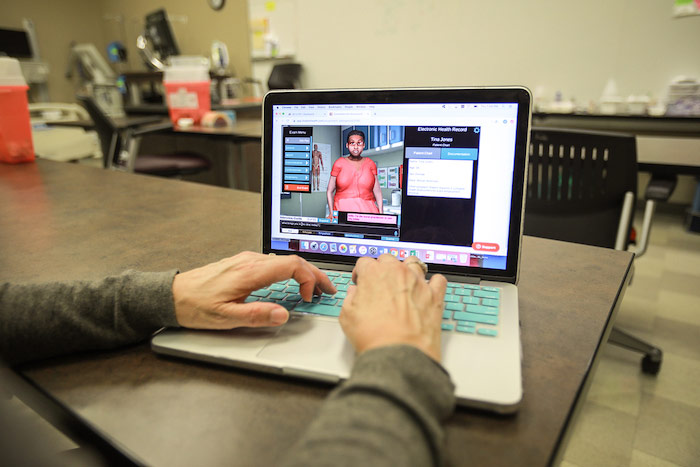
UTEP Nursing Students Care for Virtual Patients During Pandemic
Last Updated on February 15, 2021 at 12:00 AM
Originally published February 15, 2021
By Laura L. Acosta
UTEP Communications
When Sarys Vasquez started The University of Texas at El Paso’s traditional undergraduate nursing program in fall 2020, she looked forward to checking vital signs, evaluating patients and role-playing other patient care scenarios with classmates in UTEP’s Center for Simulation.

These hands-on simulations would be an opportunity for her to practice clinical and critical-thinking skills in a safe learning environment before interacting with real patients.
Although the COVID-19 pandemic caused the UTEP School of Nursing to transition from in-person instruction to remote learning, Vasquez and her classmates were able to practice their nursing skills on a digital standardized patient named Tina Jones.
Jones is a human-like avatar with whom students interact to practice their communication, physical assessment and documentation skills. The avatar is part of a software program called Shadow Health that creates a digital clinical experience.
Rosa Hernandez, clinical nursing instructor, has been using the program since summer 2020 to teach the Bachelor of Science in Nursing (BSN) program’s health assessment course.
"When performing a physical assessment, students are required to be close to one another,” Hernandez said. "This program provides a safe environment in which to complete a head-to-toe assessment on an interactive virtual patient. This virtual clinical experience provides students with the tools needed to complete a health assessment, such as auscultating heart, lung and abdominal sounds. They also can practice advanced techniques such as utilizing the ophthalmoscope and otoscope to inspect the eyes and ears. We have noticed improvement in how students therapeutically communicate and integrate teaching into their health assessments."
Overcoming Challenges
As coronavirus began to spread across the world last spring, nursing programs throughout the United States took special precautions to ensure their students were safe from contracting the virus by suspending in-person classroom instruction and on-site clinical experiences.
At UTEP, the School of Nursing adopted new online teaching strategies to engage BSN students in meaningful and safe patient exercises to support their academic aspirations. Other activities included online academic coaching and a Virtual Alternative Clinical Experience (VACE) in which students interacted with each other online to take care of a simulated patient.
Despite the challenges to nursing education posed by the pandemic, more than 97% of UTEP’s BSN spring and summer 2020 graduates passed the National Council Licensure Examination (NCLEX-RN) exam on their first try, validating the school’s efforts to provide a top-quality education during the epidemic, said UTEP School of Nursing Dean Leslie K. Robbins.
The NCLEX-RN exam is a standardized test that every state board of nursing uses to determine if a candidate is ready to begin practicing as an entry-level nurse.
In October 2020, the school received $90,000 from the Texas Higher Education Coordinating Board - Nursing Innovation Grant to implement virtual clinical experiences for BSN students during the COVID-19 pandemic. Funds will enable the BSN program to continue using the digital clinical experiences in the spring 2021 semester.
“The pandemic created numerous challenges in our undergraduate course delivery format,” said Laura Rodriguez, DNP, associate dean for undergraduate education. “This grant will allow us to teach the concepts of health assessment in a virtual format with real-time feedback. This also decreases the amount of simulation lab time required for instruction, which is necessary during this unprecedented time.”
In addition to the health assessment course, students are expected to participate in a mental health course in the summer 2021 semester, which will enable them to engage with patients struggling with different mental health conditions.
How are you feeling today?
In the virtual exam room, students such as Jessica Ibarra interacted with Tina Jones, a 28-year-old African-American woman with asthma and diabetes, who exhibited real-life symptoms such as shooting pain from a wound on her foot. Students asked her questions about her pain and pre-existing medical conditions, and they checked her ears with an otoscope and listened to her heart and lungs with a stethoscope, just as they would with a living patient. As part of the curriculum, students were expected to educate and empathize with Jones in order to increase her health literacy and sense of well-being.
“When it came to my last activity with Tina Jones, it didn’t even feel like I was working with a digital patient,” Ibarra said. “I actually felt proud of her health improvements as if she were a real patient. I feel this program really did help me with my communication skills. It helped me get practice and helped me feel more confident about what to ask my patients and how.”
In virtual labs, students explored multiple body systems. They listened to real body sounds and looked at realistic, 3D anatomical body models such as the heart and lungs to compare and contrast normal and abnormal findings.
Students were evaluated on their ability to ask effective and comprehensive questions, obtain a thorough health history, and empathize with and educate the patient. They each received feedback on what was done right and areas for improvement.
Hernandez said one of the bonuses of the virtual clinical experience is that students get to practice their therapeutic communication skills to help their future patients express their feelings and feel at ease.
However, she acknowledges that there are certain skills that are better taught in person, such as taking blood pressures. After the pandemic, her goal is to develop the digital clinical experience into a hybrid course, which will include an in-person skills lab where students can practice the skills they learned online in the sim lab.
